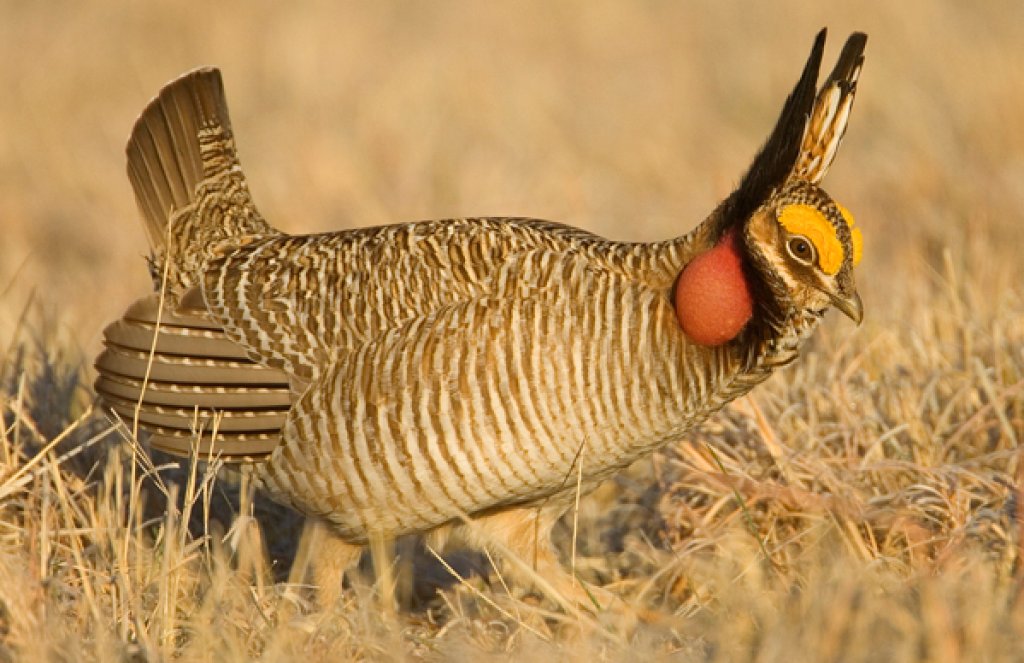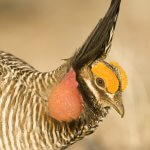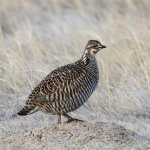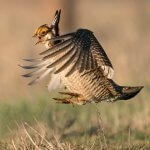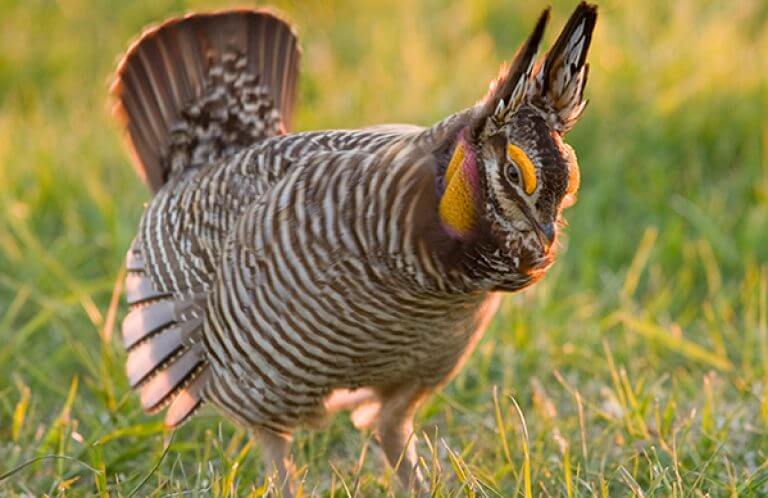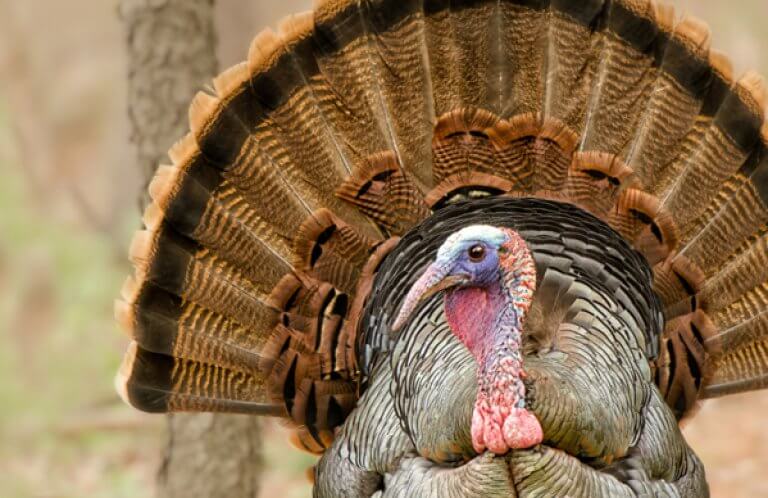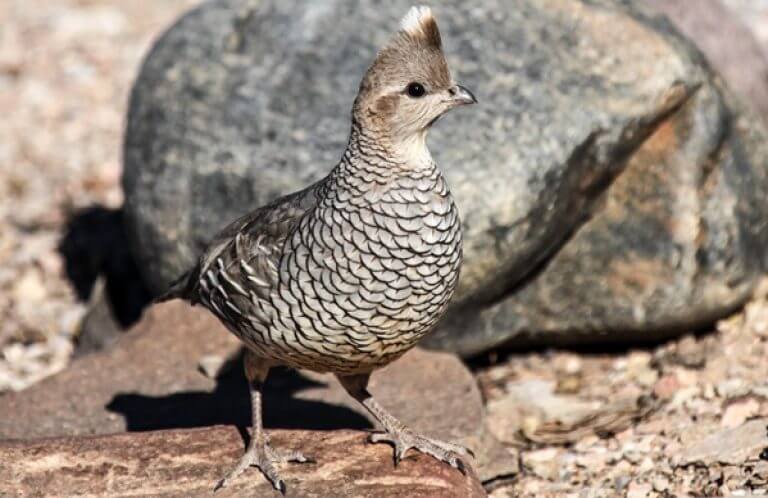About the Lesser Prairie-Chicken
The Lesser Prairie-Chicken is slightly smaller than the closely related Greater Prairie-Chicken, but it's no mere pale imitation! This species is found only on the high plains of the U.S. southwest and has distinctive courtship displays, vocalizations, and habitat preferences. Males can be distinguished by their colorful adornments, including reddish-orange air sacs on its neck that are inflated during courtship rituals. The female is more unassuming.
This bird's species name, pallidicinctus, refers to its brown-and-buff barred plumage, which is slightly paler than that of its larger relative's. Pallidus is the Latin word for pale, and cinctus means banded.
Neck Drummers
The genus name Tympanuchus is a combination of the Greek word tympanon (drum) with the Latin word nucha (neck). "Drum neck" refers to the unique resonant calls of male prairie-chickens as they inflate their neck sacs during courtship displays. Lesser and Greater Prairie-Chickens, Sharp-tailed Grouse, and Attwater's Prairie-Chicken (a Critically Endangered subspecies of the Greater Prairie-Chicken) all produce these sounds. Listen to a Lesser-Prairie-Chicken display below.
Songs and Sounds
The "booming" of a male Lesser Prairie-Chicken has a peculiar bubbling, gobbling quality; these sounds are actually produced by the bird's vocal organ (syrinx) and amplified by its inflated neck sacs. Both sexes also give a variety of cackling calls.
Booming and cackling calls from multiple males on a lek:
Andrew Spencer, XC33960. Accessible at www.xeno-canto.org/33960.
Cackling calls:
Andrew Spencer, XC33962. Accessible at www.xeno-canto.org/33962.
Breeding and Feeding
On-Stage Displays
Like the Greater Sage-Grouse, the Lesser Prairie-Chicken is well-known for elaborate displays on traditional “gobbling” or "booming” grounds, also known as leks. These avian stages are located on slightly elevated patches of open ground where groups of 10-20 males can see and be seen as they perform. During displays, males stamp their feet rapidly, raise their long neck plumes (pinnae) and tails, inflate their reddish-orange air sacs, and erect their yellow eye combs. Rival males vocalize in a weird-sounding series of gobbling calls (booms) and cackles as they face off to claim the best spot on the lek.
Displaying males also bounce as high as 10 feet into the air in "flutter-jumps" to impress visiting hens. When it comes to mate selection, the female prairie-chickens call the shots, only mating with the strongest, most dominant males on the lek.
In the way of all polygynous bird species, including the Wild Turkey, a female Lesser Prairie-Chicken is on her own after mating. She leaves the lek to nest in a shallow depression dug in the sandy soil and lined with grass, leaves, and feathers. Here she lays 11 to 13 eggs, which she incubates for almost a month. The downy chicks hatch with eyes open and leave the nest shortly afterward. The female broods her young nightly for the first few weeks after they hatch, keeping them warm, although the chicks feed themselves.
The Lesser Prairie-Chicken's diet varies with the seasons. In the summer this grassland species feeds heavily on insects, including grasshoppers, crickets, and beetles. During the fall and winter, the birds gather in flocks to dine on seeds, leaves, and waste grain from agricultural fields. They forage mostly on the ground and may fly several miles each day from roosting areas to good feeding sites.
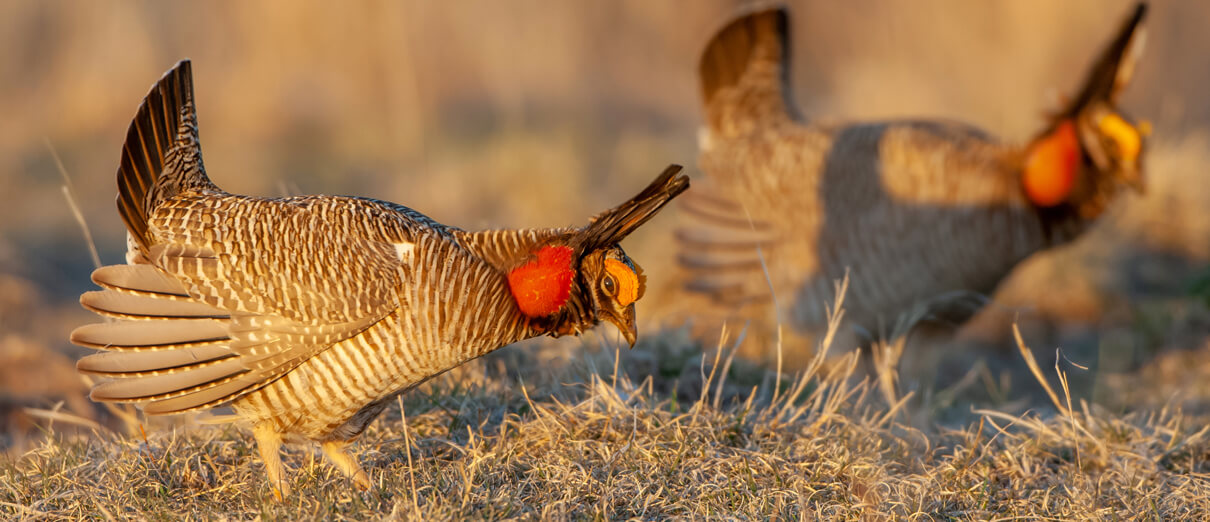
Region and Range
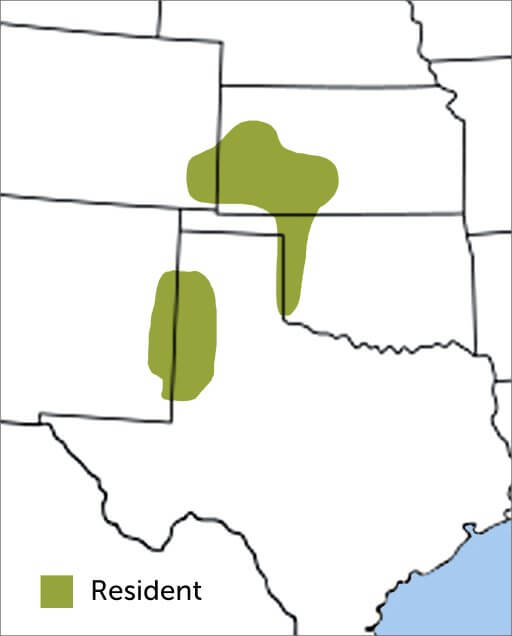
The Lesser Prairie-Chicken is resident throughout its range, which encompasses parts of Colorado, Kansas, Oklahoma, Texas, and New Mexico. It favors native shortgrass prairie on sandy soils, interspersed with clumps of sagebrush and low-growing thickets of Shinnery Oak. These habitats are shared by birds such as the Burrowing Owl and Scaled Quail.
Conservation
On a Collision Course
Habitat loss and degradation have reduced the Lesser Prairie-Chicken's range by 92 percent since the 1800s. Severe, ongoing drought and increasing demand for fossil fuels and renewable energy development (including wind energy and biofuels) threaten the species' remaining habitat. Collisions with barbed-wire fences and utility cables also cause high mortality in some areas. Because of its precipitous population decline (an estimated 97 percent since the 1800s) and its limited range, the Lesser Prairie-Chicken is classified as a Red List species by Partners in Flight.
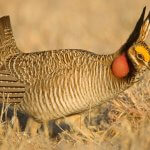
Help support ABC's conservation mission!
In 2021, the U.S. Fish and Wildlife Service proposed adding the Texas and New Mexico populations of the Lesser Prairie-Chicken — in the southern portion of its range —to the endangered species list, and to list the separate northern population in Texas, Oklahoma, Kansas, and Colorado as threatened. However, a final rule to enact the listings is now overdue, and the Center for Biological Diversity initiated a lawsuit in October 2022 to spur action.
Get Involved
Policies enacted by the U.S. Congress and federal agencies, such as the U.S. Fish and Wildlife Service, have a huge impact on the country's birds. You can help shape these rules for the better by telling lawmakers to prioritize birds, bird habitats, and bird-friendly measures. To get started, visit ABC's Action Center.
Living a bird-friendly life can have an immediate impact on the birds around you. Doing so can be as easy as adding native plants to your garden, avoiding pesticides, and keeping cats indoors. To learn more, visit our Bird-Friendly Life page.
American Bird Conservancy and our Migratory Bird Joint Venture partners have improved conservation management on more than 8.5 million acres of U.S. bird habitat — an area larger than the state of Maryland — over the last ten years. This is a monumental undertaking, requiring the support of many, and you can help by making a gift today.





































